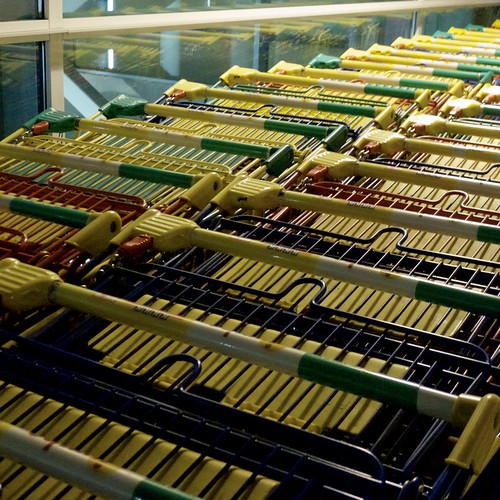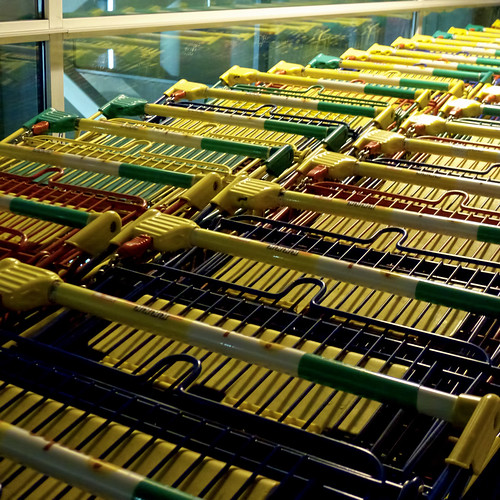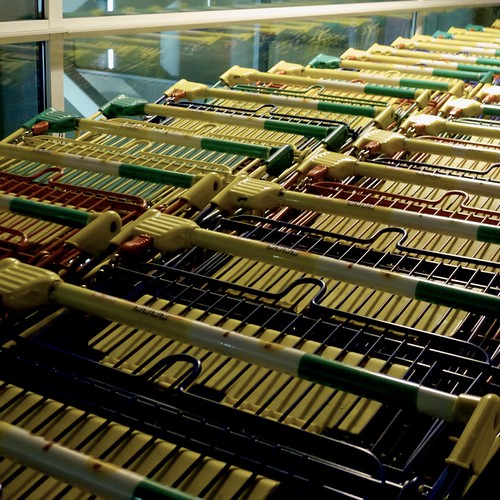I tried again ISO 1600 with noise reduction on with the LX5 firmware version 2.0. (Photographs Carts 1 and Carts 2.) I was a bit surprised of the difference between the JPEG and the RAW versions. With RAW, I tried different noise reductions settings, but didn't get very far. Maybe aperture isn't so good with scenes like this?
Also, remember to check out what Andreas found out when he tested the new firmware. Convincing!
Update: I added the third photograph, Carts 3, which was produced by Andreas from the RAW jpeg via Topaz DeNoise + Topaz Detail + Photoshop. Quite a difference! The price of Topaz ($80) seems reasonable indeed after seeing this demonstration.
Update 2: I went ahead and bought Topaz DeNoise, downloaded the free Topaz Fusion Express plug-in, and used the denoise filter on the RAW version of the photograph (RAW moderate denoise setting), and then stamped the same adjustments on the result as on the Carts 2 photograph. Looks good! Though Andreas used some of his magick on Carts 3 which I'm unable to reverse engineer.
NO PARKING
7 hours ago







12 comments:
Aperture is not best known for its noise reduction feature.
Did you use the RAW De-noise slider or the adjustments Noise reduction block? The former is actually not that bad while the latter is useless most of the time (at least clearly mediocre compared to Noise Ninja, Topaz De-noise or Nik Dfine).
@Christophe: I used the former as I thought it would be best to get the noise reduction done as early as possible in the pipeline.
Andreas processed the RAW jpeg via Topaz DeNoise + Topaz Detail + Photoshop, I added that version as third photograph to the posting. Huge improvement!
I should add that this is one of those best case scenarios for noise reduction: colorful artificial surfaces without texture, plus hard edges with much contrast. Do the same to a landscape and you have much less potential for improvement. But still, it's nice to have the tools for where they are effective.
Huge improvement indeed.
Too bad that the Aperture plug-in system requires huge intermediate TIFF files and is a destructive system.
Clearly a showstopper for me. Hope to see the system improved in AP4.
@Christophe: Indeed, the file size grew to 24 MB which is rather excessive.
But for photographs taken during the dark season, when there is no other option than to use ISO 1600, I think this is a really good option to have.
I've added some local contrast with Topaz Detail and some saturation with Photoshop. As to file size, my Photoshop files are normally in the 200-500 MB range. And I keep them :)
@Andreas: for me, the issue with file size is not storage but network throughput as my AP library is served over the network. I know I might sound crazy, but this works well with a large library and 20MB-ish RAW files. Not that much with large PSD or TIFF files.
Juha, a question for you if I may. What made you decide to start post-processing your photos? In the past, if I remember correctly, your post-processing involved nothing more than downloading your photos and culling the ones that were not keepers. Now you seem quite interested in the post-processing aspects of photography. Does this have anything to do with the LX5 or is it simply a new interest?
I like post-processing myself, in fact I tend to over do it most often but that's mostly to try and hide the technical imperfections ;)
@Cedric: Thanks for a good question, I tried answering it in a new posting. In fact, I wrote four different answers...
I downloaded a trial version of DeNoise ages ago (probably after reading a post by Andreas). Never went any further with it but I recently took a bunch of ISO800 images ... you've reminded me to consider a third-party NR tool again.
No doubt Andreas has many editing tricks up his sleeve, but you mentioned he is also using Topaz Detail ... perhaps this is the added pixie-dust you need to get [closer] to his results!
You may have already seen this ... a DeNoise group within Flickr:
http://www.flickr.com/groups/topaz/discuss/72157624634561572/
@Sven W: Thanks for the link to the Flickr group.
What has been good about these experiments in RAW post-processing and noise reduction is getting some kind of idea what kind of subjects allow raising ISO and which won't work. Foliage, gravel, wooden surfaces, plastic...
When it starts getting seriously dark here in Finland I expect to gain a lot more experience of this.
Post a Comment